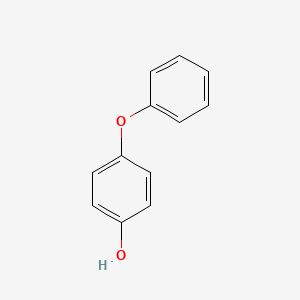D0745 | 4-phenoxyphenol
| Toxicity | Dose | Time | Species | Model | Method | Action | Positive criterion | Reference |
|---|---|---|---|---|---|---|---|---|
| MEMBRANE POTENTIAL | 27.97±10.62 | human | qHTS-HepG2 | MMP assay | decrease | IC50 | 163 | |
| MEMBRANE POTENTIAL | 47.57 | human | HepG2 | MMP assay | decrease | IC50 | 163 | |
| MEMBRANE POTENTIAL | rat | hepatocytes | MMP assay | Negative | IC50 | 163 | ||
| Pictogram | Signal | Statements | Precautionary Statement Codes |
|---|---|---|---|
 |
Warning |
Aggregated GHS information provided by 205 companies from 8 notifications to the ECHA C&L Inventory. Each notification may be associated with multiple companies. H302 (80%): Harmful if swallowed [Warning Acute toxicity, oral] H315 (100%): Causes skin irritation [Warning Skin corrosion/irritation] H317 (77.07%): May cause an allergic skin reaction [Warning Sensitization, Skin] H319 (100%): Causes serious eye irritation [Warning Serious eye damage/eye irritation] H335 (99.51%): May cause respiratory irritation [Warning Specific target organ toxicity, single exposure Respiratory tract irritation] Information may vary between notifications depending on impurities, additives, and other factors. The percentage value in parenthesis indicates the notified classification ratio from companies that provide hazard codes. Only hazard codes with percentage values above 10% are shown. |
P261, P264, P270, P271, P272, P280, P301+P312, P302+P352, P304+P340, P305+P351+P338, P312, P321, P330, P332+P313, P333+P313, P337+P313, P362, P363, P403+P233, P405, and P501; (The corresponding statement to each P-code can be found at the GHS Classification page.) |
| 2_vac_100K | 2_vac_293K | 4-(Phenoxy)phenol |
| 4-(phenoxy)-phenol | 4-(phenyloxy)phenol | 4-Hydroxydiphenyl ether |
| 4-Hydroxydiphenyl ether | 4-PHENOXYPHENOL | 4-Phenoxyphenol, 99% |
| 4-phenoxy phenol | 4-phenoxy-phenol | 4-phenoxyphenol acetone clathrate |
| 4-phenoxyphenol methanol clathrate | 831-82-3 | 831P823 |
| A840521 | AB1001902 | AC-907/25014304 |
| ACMC-209prh | AK114298 | AKOS000119371 |
| ANW-37659 | AS04657 | CAS-831-82-3 |
| CHEBI:39264 | CHEMBL224318 | CP0050 |
| CS-B0818 | D83R742GJR | DB-028997 |
| DSSTox_CID_2127 | DSSTox_GSID_22127 | DSSTox_RID_76498 |
| DTXSID2022127 | EINECS 212-611-1 | FT-0645037 |
| HX8; | Hydroquinone monophenyl ether | Hydroquinone monophenyl ether |
| KSC232S6R | LS-184899 | LS10780 |
| MCULE-3440699625 | MFCD00002331 | NCGC00257532-01 |
| NE10174 | NSC 25027 | NSC-25027 |
| NSC25027 | P0950 | PS-8471 |
| Phenol, 4-phenoxy- | Phenol, p-phenoxy- | Phenol, p-phenoxy- (8CI) |
| PubChem22528 | Q17310077 | Q175 |
| RTR-025920 | SBB090407 | SC-65293 |
| SCHEMBL74847 | ST24023638 | ST50406502 |
| STR06800 | SY001783 | TR-025920 |
| TRA0084508 | Tox21_302190 | UNII-D83R742GJR |
| VZ29217 | W-104150 | Z1262254387 |
| ZINC158246 | ZSBDGXGICLIJGD-UHFFFAOYSA-N | p-Hydroxydiphenyl ether |
| p-Phenoxyphenol |

